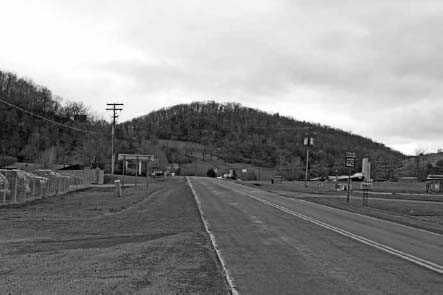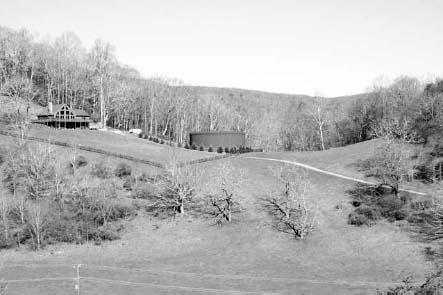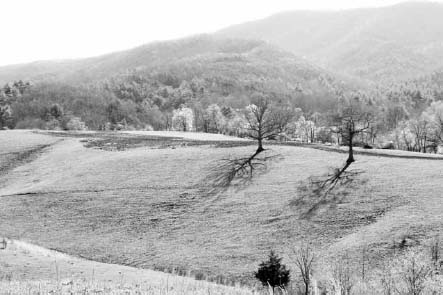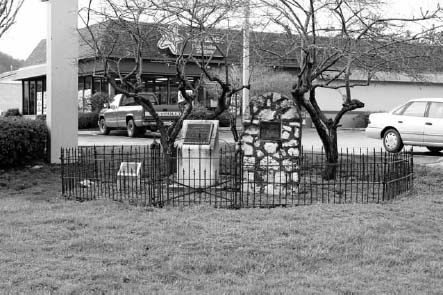The Battle of White Sulphur Springs (22 page)
Read The Battle of White Sulphur Springs Online
Authors: Eric J. Wittenberg

The next month, December 1863, Averell led the Fourth Separate Brigade on what may have been the longest, most arduous and most successful cavalry raid of the war. On December 8, Averell's brigade set out on a raid on the Virginia and Tennessee Railroad's important supply depot at Salem, Virginia. This spectacular raid destroyed three depots, five bridges, fifteen miles of track and many tons' worth of critical supplies intended for Confederate armies. This long and arduous expedition, much of which was conducted in an ice storm, covered 355 miles over thirteen days with minimal casualties and cemented Averell's reputation as the Union's most successful raider.
446
The Confederates stopped yet another long raid by Averell's brigade during the May 10, 1864 Battle of Cove Gap during yet another operation directed at cutting the Virginia and Tennessee Railroad that led to the burning of the New River Bridge by the Fourth Separate Brigade. Averell was then appointed to command a division of cavalry in Major General David Hunter's army and remained in command of that division when Major General Philip H. Sheridan's Army of the Shenandoah was formed in August 1864. However, Sheridan unjustly and summarily dismissed Averell from command in September for allegedly failing to obey Sheridan's orders to attack Lieutenant General Jubal A. Early's beaten army in the wake of a victory in the September 22, 1864 Battle of Fisher's Hill. A member of the 14
th
Pennsylvania Cavalry recalled, “The release of General Averell was a great surprise to his command who loved him greatly. He was the very idol of the 14
th
[Pennsylvania] Cavalry whom he had led into nearly two-score battles, nearly one hundred skirmishes, and more than three-score charges.”
447

This page and next
: Modern-day views of the battlefield.
Author photos
.


James E. Taylor, a Northern newspaper correspondent, watched Averell's departure from Sheridan's camps. The “sight of a big blond general on horseback” caught Taylor's eye, and the correspondent watched Averell in “earnest conversation with a dismounted officer.” Taylor had never seen Averell before, and the sight intrigued him. “It was with feelings of melancholy interest I observed him,” commented the correspondent, “while speculating on the uncertainties of a military career, for his, up to a fortnight back, was full of promise. Now he clasps his friend's hand and rides away.”
448
Sheridan exiled Averell to Wheeling to await further orders that never came. William Woods Averell never commanded troops in the field again.
Nevertheless, the New Yorker, who died a very wealthy man as one of the inventors of hot asphalt, left an indelible imprint on his command and on the Union mounted arm. The units that he trained became very effective and reliable commands that were known for their long and arduous raids. While the great law book raid of August 1863 was a failure, largely due to the determined defense by Patton's brigade of Virginians and a severe shortage of ammunition, Averell demonstrated that his Fourth Separate Brigade was now a force to be reckoned with that would be heard from again.
Today, the battlefield is hardly recognizable as a place where brave men fought and died. It certainly does not serve as an attraction for visitors to the world-famous Greenbrier Resort. The intersection of the Anthony's Creek and James River and Kanawha Turnpike has been dramatically altered by the construction of Interstate 64, which dissects the battlefield. Today, it is the intersection of U.S. Route 60 (the Midland Trail) and West Virginia Route 92. The valley portion of the battlefield, once open farm fields, is now occupied by a strip shopping center anchored by a grocery store.
The veterans erected two monuments on the battlefieldâone to the fallen Captain Paul Freiherr von König, who is described in
Appendix B
, and another to commemorate the battle itself. In the 1990s, the living history unit that portrays the White Sulphur Rifles of Edgar's Battalion erected a small monument to honor the memory of the unit it portrays. The three monuments are grouped together, and a black wrought-iron fence surrounds them. When the monuments to Baron von König and to the battle itself were erected, they sat in an open field near the location of the former Miller house and store. Then the shopping centerâcalled the Battlefield Centerâwas built, and the monuments now sit just outside a busy fast-food restaurant. If one does not know that they are there, they are very easy to miss. The only indication that a battle occurred there is a West Virginia state highway historical marker located at the road intersection.

Monuments on the White Sulphur Springs battlefield.
Author photo
.
The main Confederate position remains mostly pristine, as it is a cow pasture that is usually filled with grazing animals. A large metal water tank marks the location of Patton's headquarters. Some of the bluffs occupied by Averell's troops remain largely untouched, but the ridgeline closest to the road intersection has been changed dramatically as a consequence of the recent construction of a bank branch. In short, there is little to indicate that a ferocious two-day battle occurred at that road junction. Virtually nothing suggests the strategic significance of the narrow valley, and there is no interpretation there to assist someone trying to ascertain what occurred there. The lack of any such interpretation is tragic. With nothing to help people understand what happened there, there is really no way to pay proper tribute to the men who gave the last full measure of their devotion to the causes in which they believed on those two hot August days in 1863.
In the end, then, the Battle of White Sulphur Springs has been largely forgotten by history. Perhaps that oversight is the result of the small numbers involved, but the small numbers belie the ferocity of the two-day battle. Patton's victory not only ensured that Greenbrier County remained solidly within the control of the Confederacy, but it also ensured that the important law library situated in Lewisburg was not seized for use by the new state of West Virginia. It demonstrated beyond doubt that George Patton was a capable brigade commander, competent to command troops in independent operations, and it likewise demonstrated William Woods Averell's brilliance as a raider. Most importantly, the Battle of White Sulphur Springs, forgotten as it may be, highlights the schisms that brought about the birth of the state of West Virginia and puts a human face on the conflicts that split Virginians during the Civil War. For those reasons, the Battle of White Sulphur Springs is worthy of commemoration. Hopefully, the publication of this book will be the first step in that direction.
Appendix A
Order of Battle
Battle of White Sulphur Springs, August 26â27, 1863
U
NION
F
ORCES
Middle Military District
Eighth Army Corps
Major General Robert Schenck
Fourth Separate Brigade
Brigadier William Woods Averell
2
nd
West Virginia Mounted Infantry (Colonel George R. Latham)
3
rd
West Virginia Mounted Infantry (Lieutenant Colonel Francis Thompson)
8
th
West Virginia Mounted Infantry (Colonel John H. Oley)
14
th
Pennsylvania Cavalry (Colonel James M. Schoonmaker)
Independent Cavalry Battalion (Major Thomas Gibson Jr.)
Battery G, 1
st
West Virginia Light Artillery (Captain Chatham T. Ewing [w]; Lieutenant Howard Morton)
Total: approximately thirteen hundred men
C
ONFEDERATE
F
ORCES
Department of East Tennessee
Major General Samuel Jones
First (Echols's) Brigade
Colonel George S. Patton
22
nd
Virginia Infantry (Lieutenant Colonel Andrew R. Barbee [w]; Major Augustus R. Bailey)
45
th
Virginia Infantry (Colonel William H. Browne)
23
rd
Battalion Virginia Infantry (Lieutenant Colonel Clarence Derrick)
26
th
Battalion Virginia Infantry (Lieutenant Colonel George M. Edgar)
Chapman's Company of Virginia Light Artillery (Captain Beirne Chapman)
Other Forces
8
th
Virginia Cavalry (Colonel James M. Corns; five companies)
37
th
Battalion Virginia Cavalry (Major J.R. Claiborne; two hundred men)
Total: approximately twenty-three hundred men
Appendix B
Captain Paul Freiherr von König
On November 19, 1914, the men of the Fourth Separate Brigade dedicated a simple yet elegant monument to the memory of Captain Paul Freiherr von König on the battlefield at White Sulphur Springs. The monument was placed at the spot in the field where von König fell and was buried. Today, that monument sits just outside a Hardee's fast-food restaurant. It was the first thing that I saw on the battlefield, and it drew my interest. I set out to learn what I could of the life of Baron Paul von König and to ascertain why there was a monument to him on the battlefield. The story turned out to be as fascinating as it was difficult to divine. This forgotten hero's story needed to be told, and I realized that this book would not be complete unless I did his story justice.
The family von König dates back to 1477, when the name of a master of a guild first appeared in a document. Then, in 1561, Werner König was born. He became a legal scholar, and Duke Heinrich Julius appointed him as chancellor of the Duchy Braunschweig-Wolfenbüttel. In 1605, Werner acquired estates in Lochtum and Vienenburg, both villages situated in a fertile region at the foot of the Harz Mountains, about thirty miles south of Braunschweig (Brunswick) and about an hour from Hanover. More than four centuries later, the family estate, Edelhof, located in Vienenburg, remains in the hands of Werner's descendants.
449
When Duke Heinrich Julius died in 1611, Werner König accepted an offer from Count (later Prince) Ernst of Schaumburg to become chancellor of Bückeburg, which at the time was the cultural center of the county Schaumburg. Werner died in 1621. By then, his son Johann was already calling himself
von
König, meaning that someone had ennobled the family. The specific circumstances of the ennobling and the granting of the title Freiherr (which means “baron” in German) are not known.
450